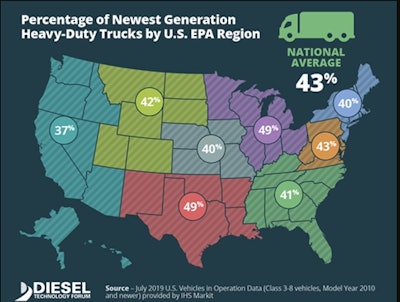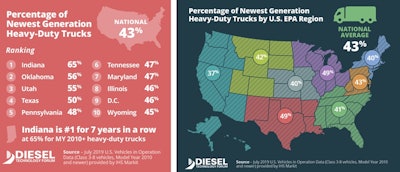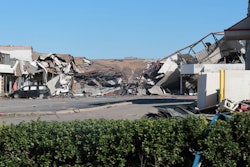
 Access an interactive version of DTF’s state-by-state metrics via this link to their website. The image above shows regional concentrations of engine model year 2010 and newer diesels among commercial vehicles registered, with some state spotlights.
Access an interactive version of DTF’s state-by-state metrics via this link to their website. The image above shows regional concentrations of engine model year 2010 and newer diesels among commercial vehicles registered, with some state spotlights.More than 40% of the country’s truck fleet is now powered by post-2010 emissions technology, according to a recent report from the Diesel Technology Forum. DTF’s research reveals that 43% of the commercial fleet is using engines with exhaust aftertreatment systems. That’s a 6.8 percent increase from the same time last year.
What’s more, DTF’s research pointed to continued dominance of diesel power, with more than 75% of all registered commercial vehicles running on diesel fuel.
A webinar conducted around the research October 22 included a state-by-state analysis, too, of the distribution of post-2010 engines among registered commercial vehicles. The state of Indiana showed the largest concentration of such diesels, with 65% of the registered fleet there operating post-2010 tech.
And despite California’s more stringent emissions requirements, it’s a laggard in adopting post-2010 tech, according to DTF research. Likewise, the entire Western region posted below-average adoption rates of modern emissions. California’s registered fleet showed just 35% of all trucks running 2010 or newer engine technology (Washington: 39%, Oregon: 43%, Idaho: 37%, Nevada: 41%, Arizona: 32%).
That’s in spite of large-market California and its Air Resources Board’s required retirement of pre-2007 engine emissions technology in its Statewide Truck & Bus Rule, with a final deadline for all trucks and buses to be powered by post-2010 engines by year 2023. During the Q&A on the webinar, DTF Executive Director Allen Schaeffer said CARB’s deadlines, he believed, had created what he called something of a “perverse incentive” for truck owners at this point not to upgrade their fleets, even as post-2010 engines have improved year by year in fuel efficiency.
“The Truck and Bus Rule has set up a situation that has fundamentally altered the market for new-technology trucks,” Schaeffer said. “The net result is that Californians are being denied the benefit of newer [diesel] technologies due to the perverse incentive put in place by the Air Resources Board. These are benefits that are accruing now.” However, California will require all trucks to be equipped with selective catalytic reduction (SCR) exhaust aftertreatment systems beginning next year.
Fuel economy is a major driver of emissions reductions, said speakers in DTF’s webinar.
Casey Selecman, with the IHS Markit advisory services group, noted that the adoption of selective catalytic reduction to meet EPA 2010 emissions requirements drove “downsizing engines and increasing power density, driving more efficiency from the combustion event than we’ve ever seen before.”
A typical Class 8 truck, which used to average 6.2-6.4 mpg fuel mileage, might “now run 10 or close to 10 mpg” in testing with newer engines and other vehicle improvements, said Selecman. “All of these technologies are helping improve efficiencies and radically reduce CO2,” particulates and NOx. “Emissions rates for Class 4-8 trucks have fallen by 90 percent compared to 2007.”
With research built to show projections to 2030, Selecman noted such improvements would continue and diesel among Class 4-8 trucks was very likely to remain the principal fuel for 80 percent of trucks in the market through that year.
Schaeffer emphasized that, though new fuels and technologies that serve as potential alternatives to diesel will play a growing role in the future, “we can’t hit the pause button on [diesel] progress today. These new findings reinforce the importance of the new generation of diesel in delivering vital societal benefits today in the here-and-now. No technology is as vitally important to achieving current and future goals as advanced technology diesel engines.”











